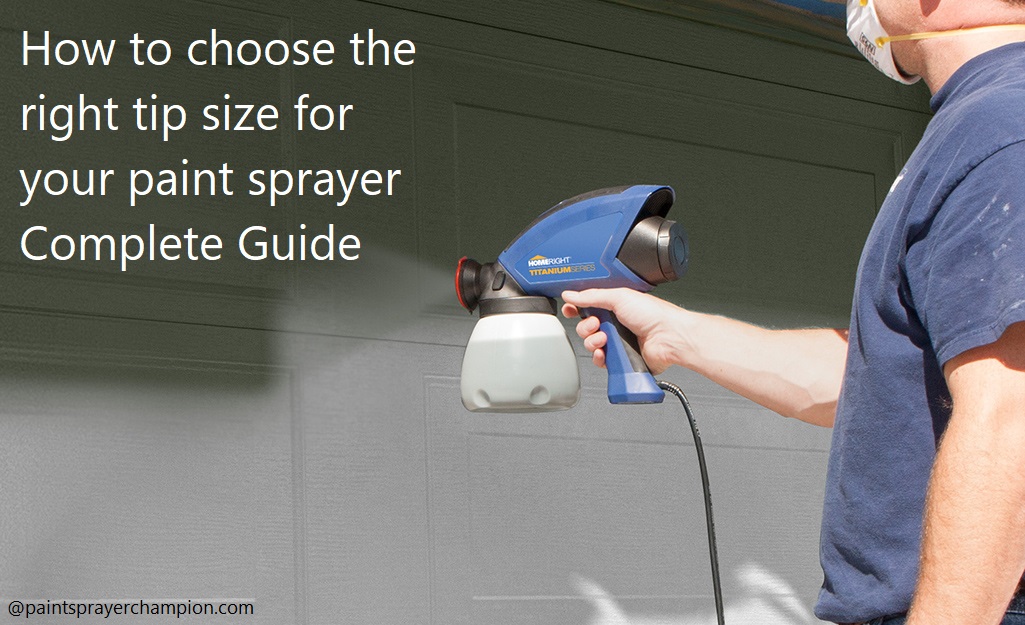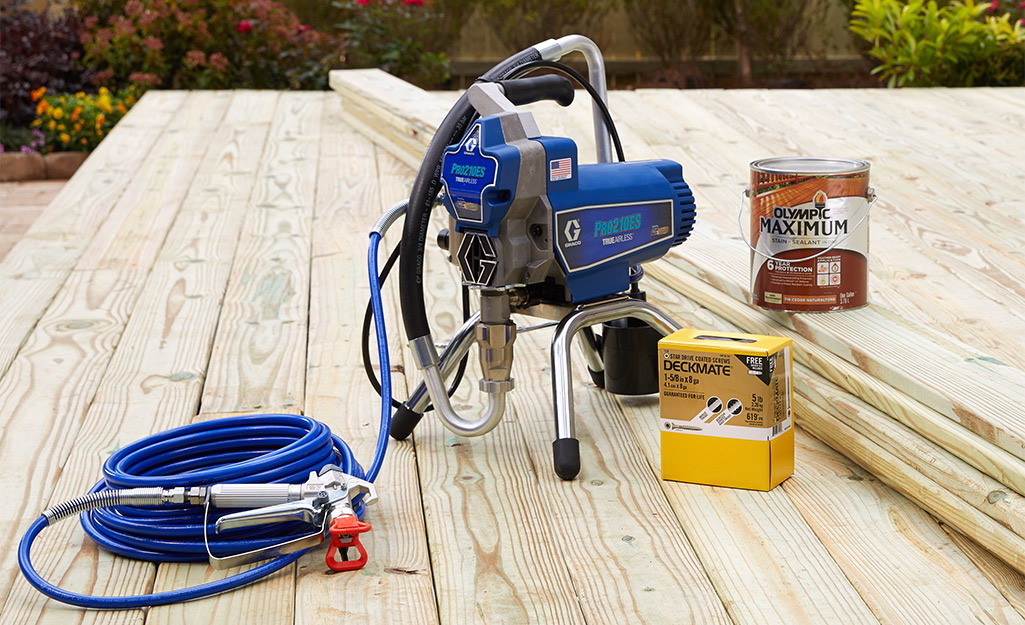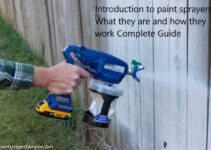Are you looking for a guide to choosing the right tip size for your paint sprayer? You’ve come to the right place – In this article, you’ll learn all about how to select the right size, what role tip size plays in painting, and other essential tips.
Get ready to make your project look better than ever!
Getting the right tip size for your paint sprayer is an important part of spraying jobs effectively and efficiently. The right tip size for a particular project will determine how much material is dispersed onto the surface being sprayed, which affects the evenness and quality of coverage. Selecting the correct spray nozzle is important to ensure that you get the desired finish and also maximize the lifespan of your sprayer by matching it with compatible accessories.
In this guide, we’ll explain how to choose the right tip size for your paint sprayer, including what to consider when selecting a nozzle, common tips sizes chart and selection tips.
Importance of choosing the right tip size
Choosing the right tip size for your paint sprayer can have a major impact on the outcome of your project. The perfect tip size will optimize time, yield, coverage and finish quality. Too small of a tip and you’ll get too much orange peel or inefficient performance due to over atomization; too large and you’ll lose atomization resulting in excessive coats and poor finish quality.
When selecting the right tip size for your paint sprayer, you need to consider several factors including material viscosity, transfer efficiency and equipment capabilities. Additionally, always double check your sprayer manual before investing in new tips; different techniques may require specific types of tips or polishing advice.
By carefully considering these factors, you’ll be able to determine which sized tip is right for your project needs. Ultimately, choosing the correct tip size will improve overall efficiency while saving time and money on expensive materials that may otherwise be wasted due to an inappropriate selection.

Benefits of using the right tip size
Using the right tip size for your paint sprayer has several benefits, including improved coverage, better accuracy, and less overspray. The right tip size also ensures that your paint sprayer operates safely and efficiently with its maximum capacity.
Furthermore, choosing the right tip size depends upon several factors, including the type of material being sprayed, the size of the project surface area, and the distance between surface and sprayer. When selecting a tip size for a paint job, it is important to consider how each of these factors may affect your results.
Here is a complete guide to help you choose the ideal tip size for your next painting project.
Understanding Paint Sprayer Tip Sizes
There are two major factors to consider when choosing the correct tip size for your paint sprayer—the type of paint being used and the surface area you’re spraying. Tip sizes are usually determined by numbers printed on the side of the spray tip and can range from 0.000004 to 0.084 inches in diameter.
Tip size affects the fan pattern, or width, of the spray, as well as how much fluid is released in each pass. Choosing a larger tip size increases fluid release and widens the fan pattern while a smaller tip stays closer to the surface area being sprayed and has a more focused coverage with less amount of fluid being released in each pass.
Standard tips come in four sizes – 1/2” (12mm), 1” (25mm), 2” (50mm) and 4” (100mm). You should always use manufacturer’s recommended tips for your particular paint sprayer as sizing varies between different models. The chart below outlines how tip size impacts both fan width and production rate for various paints for each type of standard sized paint sprayer tips:
Tip Size Fan Width Production Rate
12MM(1/2 INCH) 200-250 mm (7 3/4 – 9 7/8″) 240ml/min
25MM(1 INCH) 350-375 mm (13 3/4 – 14 7/8″) 490ml/min
50MM(2 INCHES) 500-550 mm (19 3/4 – 21 5/8″) 890ml/min
100MM(4 INCHES) 750-850 mm (29 1/2 – 33 1/2″) 1770ml / min
What is a paint sprayer tip size?
A paint sprayer tip size determines the amount of paint that can be put out for each pass, and also affects the shape in which it leaves. Paint sprayer tip sizes range from 0.009” to 0.063” for airless sprayers and from 0.007” to 0.013” for air-assisted lacquer guns; depending on the type of product you are spraying.
Different tip sizes are ideal for different types of paints, coatings, stains, and finishes; but the general rule is that larger tips should be used for thicker products, while smaller tips should be reserved for lighter products such as stains or sealers.
When selecting a paint sprayer tip size, it is important to take into account not only the specific product that you are spraying but also the intended surface finish that you want to achieve. For smooth finishes and fine detail work with thin materials like varnish or lacquer, a fine tip size would be best, while large tip sizes create a rougher finish and can save time when spraying heavier material like latex paint or enamel coating on large projects such as walls or cabinets.
Additionally, consider not only your desired look but also factor in what type of equipment you have since too small of tip size may cause nozzle clogging due to too much air pressure on the material being sprayed.
How does the tip size affect the spray pattern?
The tip size of a paint sprayer is determined by the inside diameter of the nozzle. This directly affects the size and shape of the spray pattern that a specific model of sprayer produces. Generally, larger tip sizes result in wider and thicker patterns, while smaller tip sizes create patterns that are more concentrated and finer. The shape of the pattern also varies with tip size – for example, round tips produce circular spray patterns, while rectangular tips commonly produce fan-shaped or flat-width (horizontal) sprays.
When using a painting machine with various sized tips, it’s important to note that when using an undersized tip may help reduce overspray, it won’t be as efficient as using a correctly-sized one – as over or under sized tips may result in an uneven coat or insufficient coverage due to lower output rates/pressures. When trying to match the appropriate tip for your job at hand – first consider: What type of material you’re spraying; what type of surface you’ll be working on; what kind of finish is desired; and the temperature / humidity levels within your workspace – as all these factors play an important role in selecting and optimizing your chosen painting set up.
How does the tip size affect the viscosity of the paint?
Tip size affects the viscosity of the paint. A higher pressure, which is what a larger tip size allows more gallons-per-minute liquid flow, will thin out the paint. The result will be a more even coverage, less dripping and splattering, and less thinning with aftermarket reducers or thinning agents. On the other hand, smaller tip sizes give thicker coverage of paint that generally won’t require thinning or aftermarket reducers. The thicker coverage does often mean that some runs and sags may occur without proper practice in application for beginners.
So understanding how pouring or spraying differently can produce different results is key to understanding how tip size affects the viscosity of the paint.
Different types of tip sizes
Tip sizes determine the size, shape and pattern of the paint spray produced. A narrow tip will produce a very tight spray pattern, while a wide tip will produce a broad, unfocused spray. When selecting the right tip size for your project, you must consider both the type of material you are spraying and the environment in which it is being sprayed.
When selecting a tip size, start with the largest size that will give you optimal coverage when painting large surfaces or multiple colors/thicknesses. While this may require more coats if you use a larger tip size, it can reduce the time spent trying to apply multiple layers of a small pattern resulting from a small tip size.
Tip sizes are represented by numbers that refer to fan-width openings in inches or millimeters (mm). For example, if your paint sprayer is rated for .015″ to .017″, it means that its nozzle has an opening from .015 inch up to .017 inch (about 0.38 mm – 0.43 mm). Here are some common types of paint-spraying tips:
- Stock tips: Available for most general purpose pressure pots used for interior and exterior projects; usually range between .015” and .025” (0.38mm and 0.64mm).
- Fine finish tips: Used mainly on airless pumps with universal quick disconnects; usually range between 020” and 027” ((0.51mm and 0.69mm).
- Solvent safe tips: Made of stainless steel; used mainly on airless pumps or solvent cleanable pressure tanks; usually range between 025”and035” (0.64mm–0.89 mm).
Finally, remember to always use manufacturers recommendations when selecting your paint spraying tips as variations may exist depending on type of material being sprayed and environment conditions among others variables.

Factors to Consider When Choosing a Tip Size
When choosing a tip size for a paint sprayer, there are several factors to consider. The most important factor to consider is the type of material being sprayed and the desired finish. In general, a smaller tip size can produce finer details with less coating material. Conversely, a larger tip size will allow for more coverage but may result in an uneven finish or excessive thickness. Additionally, the type of sprayer being used, the speed at which it operates, and the distance between the tip and the target surface all affect what size of tip should be used.
For materials such as latex or acrylic-based house paints, gloss enamels, or lacquers, it is recommended to use a relatively small and narrow tip of about 0.015 to 0.021 inches in diameter (15-21 thousandths). For thicker materials such as block fillers and sealants, a larger aperture should be used such as 0.025 to 0.029 inches (25-29 thousandths). When painting furniture or cabinets with satin water based finishes and sealants that require an even coverage on uneven surfaces such as intricate moldings or carved details then use a larger tip diameter such as 0.033 to 0.035 inches (33-35 thousandths). Finally when spraying industrial coatings (epoxies) which require high pressures then you will need to use an appropriate large short-tip nozzle specifically designed for airless systems that delivers more material due to higher fluid pressures achieving better atomization for improved coverage in fewer passes over your surface.
Type of paint being used
- Type of paint being used – The viscosity and consistency of the paint will be one of the primary factors in choosing the right tip size for your project. Thin, watery paints need a smaller tip that produces a more fine spray pattern, while thicker paints are best suited for larger tips that create a wider spray pattern. As a general rule of thumb, latex paints will require tips that range between 0.015 to 0.019 inches, while oil-based paints should use tips from 0.017 to 0.021 inches or beyond.
You can also adjust the pressure on your sprayer to better control how much paint is released; higher pressure is better for thicker paints and lower pressure is optimal for thinner materials.
Project size and scope
Depending on the size and scope of your project, you will need to choose an appropriate tip size for your paint sprayer. The traditional rule of thumb is that a larger tip will be sufficient for large projects while a smaller tip is better suited for small projects with intricate details.
When selecting the right tip, consider the surface area you are working on, as well as the type and thickness of the material being sprayed. For example, on a larger piece such as an exterior wall or bulkhead, you may be able to use a 0.015-inch nozzle for even coverage. For smaller projects such as baseboards or trim work where precision is key, you may need to switch to a 0.011-inch nozzle.
It will also help to know the approximate surface area you will be spraying before making your selection so that you can take into account how long it will take for each coat of paint to dry in between applications. With these factors in mind, make sure to pay attention to manufacturer recommendations when selecting an appropriate size nozzle and accessories for your project so that you can achieve optimal results with minimal effort.
Surface being painted
When determining the right spray tip size for a paint sprayer, the surface being painted should also be taken into consideration. The larger the surface, the higher the flow rate of paint that is needed. Consideration should also be given to how thick or thin the paint is and how much overspray needs to occur in order to obtain full coverage. In general, smoother surfaces require a smaller tip size and rougher surfaces a larger tip size.
A smooth surface will require a smaller spray pattern and less pressure than a rough surface so that you don’t have to worry about clogs due to over-applying paint or pressure issues due to too low of pressure. If you are spraying a large area, it may also require more passes and more frequent filter changing in order to avoid any problems with your equipment clogging up.
The type of material being sprayed is important as well; latex primers tend to be thicker while exterior wall paints tend to be thinner. Depending on what you are working with, you may needto use an even smaller or larger tip size than normal in order to achieve optimal coverage but still avoid over-applying or lack of coverage due to too low of pressure. Be sure you’re aware of what material you’re working with and take regular breaks for filter changes if necessary so that your painting job turns out perfect every time!
Spray pattern required
When selecting a tip size for your paint sprayer, it’s important to consider the type of finish that you want to achieve. Different tip sizes will produce different types of spray patterns, which will have an effect on the coverage and the quality of the finished product. Generally speaking, larger tips are used for spray guns with heavier viscosity materials and for wider coverage areas, while smaller tips are typically used for lighter viscosity materials and more detailed work.
When selecting a tip size, it is best to consult your manual before purchasing a spray gun or trying to modify an existing one. Different paint viscosities require different tip sizes in order to achieve the best possible finish. In general, it is recommended to choose a tip size based on the spray pattern you need – ranging from narrow fan or narrow cone shapes up through wide fan or wide cone shapes.
For example, a wide fan shape is excellent for covering large areas quickly and evenly with a soft edge in mind. While narrower fan shapes are great for intricate details and small curved surfaces like trims, smaller areas and tight corners in corners and edges should be covered with conical nozzles. Conical nozzles offer more concentrated spray at the center of their pattern than tilted (or curved) nozzles do at their edges so that edges wear less quickly from spraying pressure.

Conclusion
In conclusion, it is important to pay close attention to the size of your paint sprayer’s tip when you are choosing a tip for your paint job. The correct tip size can make the difference between a successful and efficient job, and an unsuccessful and inefficient one.
Remember that the right tip will depend on what type of project you are working on, as well as how far away your work surface is from the sprayer, how much paint you are using, and what type of material you are working with. By using this guide as a reference, you can be sure to choose a paint sprayer tip that is appropriate for your needs.
FAQ’S
How do I know what size spray gun tip I need?
The size of the spray gun tip depends on the viscosity of the material being sprayed and the surface area to be covered.
What size tip is best for spraying emulsion?
A tip size of 1.8-2.2mm is recommended for spraying emulsion.
What is the difference between 1.3 and 1.4 tip spray gun?
The 1.3 tip spray gun produces a finer mist pattern and is suitable for thinner materials, while the 1.4 tip spray gun produces a larger pattern and is better for thicker materials.
What size tip is best for spraying doors?
A tip size of 1.4-1.6mm is recommended for spraying doors.
Can you spray primer with a 1.4 tip?
Yes, a 1.4 tip spray gun is suitable for spraying primer.
What is 211 spray tip used for?
The 211 spray tip is commonly used for spraying lacquers, varnishes, and urethanes.
What size tip is best for clear coat?
A tip size of 1.2-1.4mm is recommended for spraying clear coat.
What tip is best for spraying walls?
A tip size of 1.8-2.2mm is recommended for spraying walls.
What size spray tip for enamel paint?
A tip size of 1.4-1.8mm is recommended for spraying enamel paint.
What is a 311 spray tip used for?
The 311 spray tip is commonly used for spraying latex paints, as well as some stains and sealers.
See Also:
- Best paint sprayer for trim
- Best paint sprayer for interior walls
- Best air compressor for paint sprayer
- Best paint sprayer for furniture
- Best paint sprayer for fence


